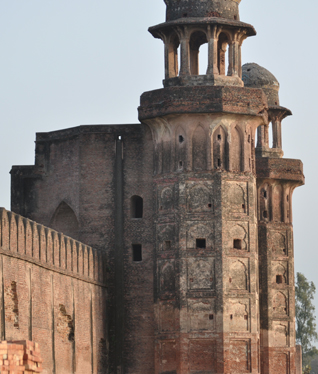Architecture
International Experts Raise Alarm Over
Condition of Punjab’s Forts
JAIDEEP SARIN
The Punjab Government has taken a US $48 million loan from the Asian Development Bank for promoting cultural heritage tourism. Where's the money? What happened to it? Is the Bank monitoring the application of the funds and demanding accountability?
More importantly, why is India still seeking -- and getting -- loans from abroad? Are Indians continuing to ply their begging bowls ... and why are the millions and billions of tax payers' money ending up in politicians' pockets ... while nothing is being done?
The International Committee on Fortifications and Military Heritage (ICOFORT) has raised an alert that Punjab's magnificent forts and other heritage structures need a public awareness and official restoration plan if these historic symbols of state power can be preserved for future generations
After touring heritage structures, especially forts, in Punjab for nearly 12 days this month, the 19-member team of experts, mostly from European countries, felt that though satisfactory work was being done to maintain forts in Punjab, a comprehensive restoration plan could help better preserve the state's rich heritage.
"The forts (in Punjab) need a good restoration plan. Rain and other conditions damage the restoration after some time. The difference between a restoration plan and repair must be understood. At some places (in Punjab), only repairs are being undertaken," Hans-Rudolf Neumann, who headed the ICOFORT team during the tour, said.
"I feel that engineers and architects should be sent to other places and countries to understand how restoration is done. Restoration takes a long time, even 10-15 years. It is not a question of spending money alone; experienced people are also required," Neumann added.
He said that the team was quite impressed with the heritage available in Punjab.
"Restoration of forts in Punjab is necessary for the national identity of the Sikh and Punjabi people. When people know about their history, they feel proud. Also, there is a need for more education of people about their heritage," Neumann pointed out.
The team, which included experts from Australia, France, Finland, Germany, the Netherlands, New Zealand, Switzerland, Turkey and Ukraine, visited forts and heritage structures in Patiala, Nabha, Bathinda, Patti, Amritsar and Chandigarh.
The team also saw 'sarais' (fortified structures for resting) along the Mughal-time imperial highway, later called the Grand Trunk (GT) Road and now National Highway No. 1.
Neumann said that the team's experience about the heritage structures along the GT Road was "unique".
"Their objective was to know about these forts, both from the perspective of the historical narrative and from the point of view of technology and material of the past and the current conservation and management scenario of these sites," leading conservationist Gurmeet Kaur Rai, who was with the team for some time, said.
"The visit of these experts is an opportunity to highlight the heritage values and conservation challenges and the need for the government to understand that heritage conservation is more than the 'fixing' of old buildings," Gurmeet Kaur added.
Punjab has taken a Rs.300 crore (US $48 million) loan from the Asian Development Bank (ADB) for promoting cultural heritage tourism.
"Forts were the symbol of state power. Unlike the forts in Europe and some other countries which were only for military purposes, the forts here were multi-purpose ones with palaces, gurdwaras and other buildings inside," Neumann said.
Having studied the Bahadurgarh Fort near Patiala, Bathinda Fort and the Gobindgarh Fort near Amritsar, Neumann and his team felt that there were definite European links to the architecture and design of these structures.
[Courtesy: New Kerala. Edited for sikhchic.com]
February 27, 2015
Conversation about this article
1: Kaala Singh (Punjab), February 27, 2015, 11:19 AM.
The economy of Punjab is on the "ventilator" with a debt of more than 20 billion dollars. It is only a matter of time before the whole system collapses.
2: Gurinder Singh (Stockton, California, U.S.A.), February 27, 2015, 12:15 PM.
"It is only a matter of time before the whole system collapses." Just like a house of cards it'll be with India, as it happened in the old-time Soviet Socialist Republic.
3: Baldev Singh (Bradford, United Kingdom), February 28, 2015, 8:40 AM.
The neglect and lack of adequate action is disturbing!
4: Kaala Singh (Punjab), February 28, 2015, 12:42 PM.
Punjab can become a major tourist destination and earn good revenue if it takes care of its heritage. The Khalsa heritage complex in Anandpur Sahib has proved this. Tourism has improved the local economy and created employment opportunities. There is an urgent need to diversify and shift focus from agriculture to other industries.
5: Gurjender Singh (Maryland, USA ), February 28, 2015, 1:35 PM.
International experts raise the issue but the SGPC and gurdawara managements have no knowledge about preservation and conservation of the properties under their control. For example, it is a shame that they replaced the original wall of Sirhind with marble, where the younger sons of Guru Gobind Singh ji were buried alive by Aurangzeb. It should have been preserved for the future generations.
6: Kaala Singh (Punjab), March 01, 2015, 3:28 AM.
@5: Have you seen any person with a proper education in the SGPC or for that matter the Akali Dal that controls the SGPC, to have understood the importance of the original wall? Guys like these are the custodians of Sikh heritage and our homeland of Punjab. I also remember what the Badals used to say, that they will get "truckloads" of money after the BJP comes to power. Well, where are those "trucks" and why do they now have to borrow money from the ADB and where did that money go? This loan will only add to the debt of Punjab, especially if it doesn't produce anything.




